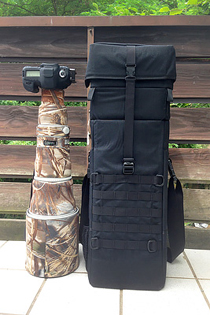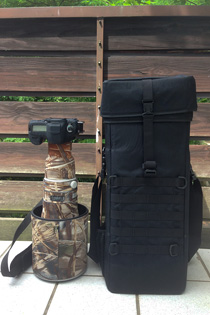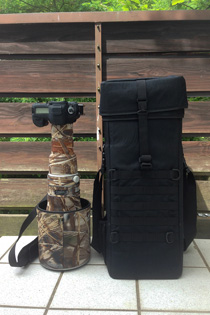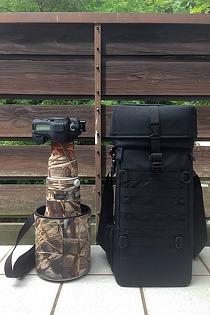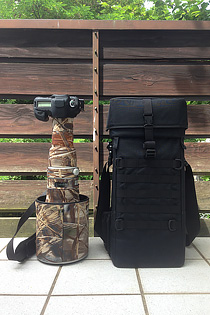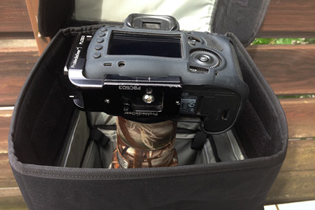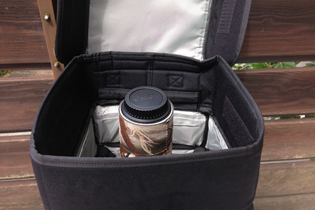equipment reviews
lenscoat 4xpandable
I am sure there is no nature photographer on the Earth who wouldn't know LensCoat — a US company that makes neoprene protective and camouflage covers for very many DSLR lenses. I the last couple of years LensCoat was constantly extending not only the number of lens models they were making covers for but also the offer of other products, such as — pouches, rain protection covers, etc. Finally, this year the company debuted in the photo bag market segment with a new series of large lens bags called Xpandable.
The Xpandable long lens bag series currently consists of 2 models — 3Xpandable and 4Xpandable. The first is with 70cm of maximum height a little smaller and therefore more suitable for lenses up to 400mm f/2.8 of Canon and Nikon, or 500 mm of Sony and Sigma. Larger lenses can be put into it either without a camera attached or with hood reversed. In that case, also the high tripod foot may be an obstacle that will need to be removed or replace with a shorter third-party foot.
The 4Xpandable is 73cm high which makes a big difference because it can accommodate a 800mm or even 600mm Canon or Nikon lens mounted on a camera, with hood in shooting position and even with a 1.4x or 1.7x (Nikon) teleconverter. (For unknown reason it is made too small for a 2x teleconverter. A combo hood + lens + 2x TC + camera can still be carried in 4Xpandable but with a lot of tension of the cover. It surprises me that just 3 or 5 centimeters are missing that could make the fit perfect.)
Anyway it is the tallest lens bag currently on the market and one of only 2 that are capable to accommodate a 800mm or a 600mm lens with a hood on and a camera mounted. The following table shows a comparison of all bags for super telephoto lenses that are currently in production and that I am aware of.
| Manufacturer | Model | Interior dimensions, cm | Weight, kg | Backpack |
Maximum lens fit (with camera and hood attached) |
| LensCoat | 4Xpandable | 73 x 22.8 x 22.8 | 1.2 | no* | 600mm/800mm |
| Kinesis | L622 | 67 x 20 x 20 | 2.1 | yes* | 600mm/800mm |
| König Photobags | LensPacker 2 | 58 x 19 x 19 | 0.9 - 1.8 | yes* | 400mm |
| Lowepro | Lens Trekker 600 AW II | 23 × 17.7 × 61 | 2.8 | yes | 400mm |
| Tenba | Transport LL600 II | 57 x 22 x 18 | 2.8 | no | 400mm |
There are, of course, dozens of bag models that can accommodate any lens with the hood reversed and without a camera attached, but they aren't within the scope of my interest because they are of no use in the field, when you need your camera always to be ready for shooting. In the bags offered by Lowepro, Tenba and König Photobags that are mentioned in the above table 800mm and 600mm can be carried with a camera mounted, and in LensPacker 2 by König Photobags even with a teleconverter but with the hood reversed. Therefore these three bags can be used only with the limitation that you need time for putting the hood on.
It looks like 4Xpandable is currently the only bag on the market that comes close to satisfying my requirements for a long lens bag, namely:
- to accommodate my wildlife photography equipment completely assembled: a 600mm lens with the hood on, a teleconverter (up to 2x Canon Extender III) and a camera attached;
- when empty, to be packed in a compact way for transportation in other baggage separately from photographic equipment.
Therefore, I ordered a 4Xpandable bag soon after it was released.
Xpandable is a unique concept and has a quite ingenious design: The height of the bags can be adjusted through folding the walls at the top. To better understand what I am meaning, watch this video at Vimeo: Folding Xpandable Long Lens Bag. This way, an Xpandable bag can have of of three heights as shown in the images below. At each height it can accommodate either the lens with an attached camera and a hood reversed, or a lens with an attached camera, a hood reversed and a teleconverter, or with the hood in shooting position.
At full height 4Xpandable can accommodate a 600mm or 800mm lens with hood on, and with a 1.4 teleconverter and a camera attached. The same setup but without a TC is a little shorter than the bag. The bag is too short when a 2x teleconverter is attached. Then it is of the same height as the lens with hood and a teleconverter, but no space for the camera remains (See the pictures below). In that case, you can carry the equipment with camera mounted but the lid won't close completely.
For an owner of a 600mm or 800mm lens using the bag folded to the middle position doesn't make much sense except situations when it needs to be carried with a 2x TC. However, the hood needs then to be reversed which isn't much different than when the bag is completely expanded, and you carry the lens with teleconverter and hood in it, and only the camera separately. In both cases preparation for shooting will take some time when you'll be putting the hood on or attaching the camera.
Maybe the middle folding position makes more sense for users of smaller lenses. However, I can't judge about this because I have no such lens to try it out with my 4Xpandable. It appears that the lowest, i.e. cuffed, position is of more practical importance because it allows to reduce the size of the bag to minimum that is convenient for transportation and even would fit the limits required by airlines for carry-in luggage.
My favourite feature in Xpandable is its ability to be folded flat. This is possible from any of three sizes — when the bag is fully extended, folded to medium height, or cuffed. When folded in cuffed position, i.e. at minimum height, Xpandable is surprisingly compact, and can be put inside any item of my big luggage for transportation — in a trekking backpack, in a sea sack among cloths, in a waterproof case with equipment, etc. At location, I can fold it out and carry my big lens an a camera in it. This is the main reason why I preferred 4Xpandable to the only alternative that is worth to be considered for 600mm and 800mm lenses — Kinesis L622.
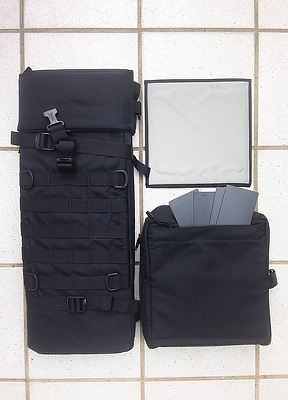
Both bags of Xpandable series can be folded flat for transportation and storage. My 4Xpandable was shipped as shown here.
As shown in the picture on the left, for an Xpandable to be folded flat, the closing cap and the bottom insert need to be removed. These items need to be carried separately. I also remove 4 pieces of plastic that are used to stabilise the walls of the bag when it is folded to full height. This isn't required, however, but I receive my Xpandable bag it this state.
Like almost all LensCoat products, Xpandable are available in 4 different patterns: black, "Digital Camo", "Realtree MAX4", "Forest Green Camo". I have chosen black not only because I don't like camouflage patterns but much more because other people when they see such bags may think that some sort of military equipment is inside it. In some countries it may be fatal. Instead of black I would have preferred olive green or sand brown but unfortunately LensCoat doesn't offer such colours.
A separate word should be said about cost. The Xpandable bags are available for 279$ (model 3) and 289$ (model 4). Like with majority of LensCoat products this price is too high in an absolute sense but may be justified in a relative. Just think how many people do you know who have a lens for 15,000$ or even for 9,000$, and who use it to photograph wildlife. There are probably only several hundreds of such customers worldwide, and not all of them will choose the same product. The need for single item production is the main reason why long lens bags are so rare. This is also the reason why such exclusive products are more expensive than those that are produced for masses of photographers. Of course, other logic may apply here too: Someone who could afford a 15,000$ worth lens would be able to spend 300$ for a bag for it.
In my opinion, it is too expensive for buyers outside the USA nevertheless. In Germany, if you order 4Xpandable directly from LensCoat, you'll pay at least 65$ for shipment. Then the total will be 354$. When it arrives, you'll be charged with 2.7% customs duty and 19% VAT. Then the real amount you have paid for 4Xpandable will be around 430$, or at least 320€ (at exchange rate for the time of writing). The best offer that I know from a German dealer is 4Xpandable for 289€, i.e. almost 30% more than the US price, but you don't need to pay that much for shipment. However, you'll always pay the same or more than any of the alternatives mentioned in the table costs in German shops. (For comparison, Lowepro Lens Trekker 600 AW II is currently priced at 180€ in German Amazon.) Whether Xpandable is worth this money depends on your preferences or personal needs as a photographer. In terms of quality, this bag isn't any better than the alternative products of other manufacturers. It is its special design what matters. In the next sections of this review I am giving my analysis of pros and cons of 4Xpandable that may help to make the right decision someone looking for a bag for a 600mm or 800mm lens.
critique
I have chosen an Xpandable bag for two main reasons: because it can accommodate my equipment fully assembled and because it can be folded flat. These two advantages outweigh vor me the rest. Like any other bag, Xpandable isn't perfect and even has some irritating issues that I am going to discuss below but overall I feel that it meets my specific requirements so far.
advantages
- Volume and size enough for a 600mm or 800mm lens with attached camera body, hood and a 1.4x teleconverter. I have no Nikon equipment and can't test, but I'd expect that any Nikon TC to fit as well. A combo with a 2x TC may also go but not that easy.
- Foldable. This is the best feature which is unique to Xpandable. Due to it, the bag can be easily carried in baggage and doesn't need to be an additional piece itself.
- Adjustable height. This is another practical feature for several reasons. First, photographers who own two large lenses of different size — for instance, Canon 200-400 or 300 f/2.8 in addition to 600mm or 800mm — but don't need to have them both at the same time in the field would appreciate this. Second, some people may need to take only the most valuable lens and a camera in cabin luggage on flights while the rest of the equipment goes in the main baggage. Then Xpandable can meet the standard size requirements of airlines when it is folded to minimum height. I also can imagine situation when the size of a bag has to be temporarily reduced to make it more compact for carrying in a car or on a boat.
- Very low weight. Compared to any alternative currently on the market, Xpandable weighs very little. Only LensPacker made by König Photobags is similarly lightweight. Although, Xpandable isn't designed for carrying at long distances, photographers who anyway have a lot of equipment in the field would appreciate if the bag wouldn't add another kilogramme to it, even if they don't carry it far. Of course, such low weight is great for anyone who needs to travel by airplane.
deficits
- No fixation for the lens and camera inside the bag. Even when it is the biggest camera and lens combination, too much space remains free around it. I don't see the reason why 4Xpandable is made so wide — almost 23cm — when the hood of the largest lens on the market is only 19cm of diameter and the length even of a large professional camera body doesn't exceed 15cm. As a result your 15,000$ worth equipment is jumping and bumping with the rhythm of your movements when you are carrying the bag. My lens has a shorter tripod foot (made by Wimberley), but even if it were the original foot, it would be still too short to prevent side movement of the lens in the bag. The walls of Xpandable are quite flexible, and the bag changes its shape a little every time when a heavy lens falls to one of the sides. Even if there would be a larger foot, it would rather bulge a wall than the wall would prevent the movement of such a 4-5kg heavy object. Hence, when the lens falls at one of the walls, the space between it and the opposite wall would always increase. All other manufacturers provide in their lens bags means, such as pads, dividers, belts, for fixation of the equipment. Of course, not all of them can be realised in Xpandable due to its top-loader construction. A possible solution would be a padded collar like “Foam Doughnut” (L026) offered by Kinesis in their long lens bags.
- Poor horizontal stability when carried as backpack. It doesn't matter what kind of harness you use, your Xpandable will be shaking sidewards all the time because the bag is too narrow and the belts are attached in the middle of its width.
- Too few possibilities for attachement of extensions. The M.O.L.L.E webbings are only at the front side. If you attache a pouch with a lens or a bag with accessories, it will increase the depth and the depth-to-width ratio, thus reducing the already poor horizontal stability: you will “wave” the bag every time when you will turn your body. Also the additional weight on the frontside will be too far from your body and will be pulling your body backwards, thus decreasing carrying comfort and ergonomics even further. There are not large accessory pockets and not further attachement points for add-ons at other sides of Xpandable.
- Tripod attachement isn't good for heavy tripods. When you attach a tripod, an empty Xpandable falls immediately at the right side because it is very high, very lightweight, and has a very small footprint. There is no way to put something as counterweight on the opposite side because there are no large pockets or attachement points except a mesh pocket for a water bottle and a flat pocket suitable only for a map or similar. Therefore, an empty bag will never stand with a tripod attached. You have always to watch for the tripod when you pull out the lens, otherwise your expensive tripod head will every time hit stones. You always have to load your Xpandable in the same sequence: first the lens and the camera, then the tripod. When unloading, the tripod goes first.
- Not suitable for long carrying. Even if you aren't carrying anything else, the bag itself, the gear inside and the tripod combined may weigh around 10kg. Xpandable isn't designed at all for carrying such loads for long periods of time and at large distances. No harness would make Xpandable a trekking backpack. A heavy weight has to be placed mainly on waist, not on shoulders. This never happens in Xpandable. The optional harness consists only of two shoulder belts, hence it is nothing else than only a replacement of the originally supplied single shoulder belt that allows carrying on two shoulders instead of one. This may be helpful for moving the loaded bag around in your shooting location but not for day long carrying. The waist belt which is also sold separately won't help much too because it only serves for fixating the bottom of the bag and isn't designed like large padded harnesses of trekking backpacks. Even a Lowepro S&F Deluxe Technical Belt that I use instead doesn't the job well because the Xpandable bag — just like in the original belt — is attached to it at the sides and not in the middle.
- A bit too small for a 2x teleconverter. As already mentioned above and shown in the pictures, when the hood is in shooting position, the maximum height of the bag isn't enough for a 600mm or 800mm lens and a 2x teleconverter. 4Xpandable can still accommodate it but with some difficulties. The height is just right for a 600mm lens with hood on, a camera and a 1.4x TC. For me it is not a very important issue because I rarely shoot at 1200mm. 800mm lens owners most likely wouldn't need it at all.
- Maybe a not so good value for money if purchased outside the US. I already discussed this issue in the previous section and am mentioning it here among disadvantages for completeness. I don't like to criticise prices because a price usually reflects both the value of a product and the demand for it. If adequate numbers of Xpandable are being sold for 279$ or 289$ then this means that it is worth this money and there is a demand for it. Instead everyone can get a different product for a similar amount of money or for less that would have other but not worse characteristics and qualities. Buyers in other parts of the world than North America may need to consider this option.
improvement suggestions
Here are some improvement suggestions for the case if someone from LensCoat team would read this review:
- Increase the minimum height by 3-5cm. This will allow to keep a 2x teleconverter attached in both positions — when the bag is cuffed and when it is expanded to full size.
- Provide means for fixation of the lens and camera when they are inside. That can be a padded collar, pads or similar.
- Make the walls of Xpandable more stiff. First, this will additionally reduce the side movements of the equipment in the bag. Second, a more stable shape of the bag will also be better for tripod attachement. Third, the attachment of harnesses and waist belts will be improved this way.
- Provide M.O.L.L.E. attachment points at the sides of Xpandable bags in addition or instead of those that are now on the front.
- Provide an optional complete harness system, like in trekking backpacks — with padded waist belt included.
conclusions
This bag could be great as a pouch for a ready-to-use long lens and camera combo when you need to transport it in a car or on a cart, such as on Eckla Beach Rolly (see a review Eckla Beach Rolly). Travel photographers who go to African or Indian national parks may find Xpandable particularly nice to use in safari cars — when the equipment has to be ready for use but at the same time to be protected from dust and hits when the car is moving. Being a wildlife photographer, I need this bag for use at locations where I arrive for shooting with all my baggage, but then have short walks to search for a particular subjet while the rest of equipment remains in a base camp or in a car.
Overall, I do not recommend Xpandable for situations when it needs to be carried over long distances. If you are looking for a backpack for hiking or trekking with your largest telephoto prime lens always ready for shooting, LensCoat Xpandable isn't for you. Unfortunately for this area of use there is still no perfect solution for 600mm-800mm lenses. Photographers with such demands have to choose from 3 compromises — 1) to get one of the bags mentioned above, i.e. made by Kinesis, Lowepro, Tenba, König, and carry the lens with hood reversed; 2) to use a normal trekking backpack with some kind of padded insert; 3) to go for LensCoat 4Xpandable. I did the last, and 4Xpandable became a nice addition to my two other bags — F-Stop Gear Satori EXP that serves me as trekking backpack (see a review F-Stop Gear Satori EXP), and Lowepro Flipside 300 that I use during short excursions with little equipment. I don't plan to hike with 4Xpandable on my back a lot.
As I explained above, the 4Xpandable model is too wide even for the largest prime lens, which is currently 600mm f/4. For owners of 800mm f/5.6 lenses who don't use teleconverters very often and have replaced the tripod mount foot with a shorter one I would recommend to take a look at 3Xpandable. Its diameter is 19cm, and it should fit the lens better. However, this bag is 3cm shorter than 4Xpandable — too short even for a 1.4x teleconverter. Owners of a 600mm f/4 lens, like me, would probably use teleconverters more often. Then 3Xpandable may be only an option if you'd agree not to carry the lens with a TC attached or to carry it with the hood reversed.
If you don't need your large lens bag to be foldable, i.e. if you don't transport your equipment to shooting location in other bags and cases, take a look at Kinesis PolyCore L622 bags instead. These bags are more advanced and better for long carrying.
For the reasons that I have explained in this review, I mean that Xpandable bags aren't worth to be purchased outside the US by anyone who doesn't absolutely need their unique capabilities — at least as long as trade treaty between US and EU isn't signed, and custom duty and import VAT apply.
